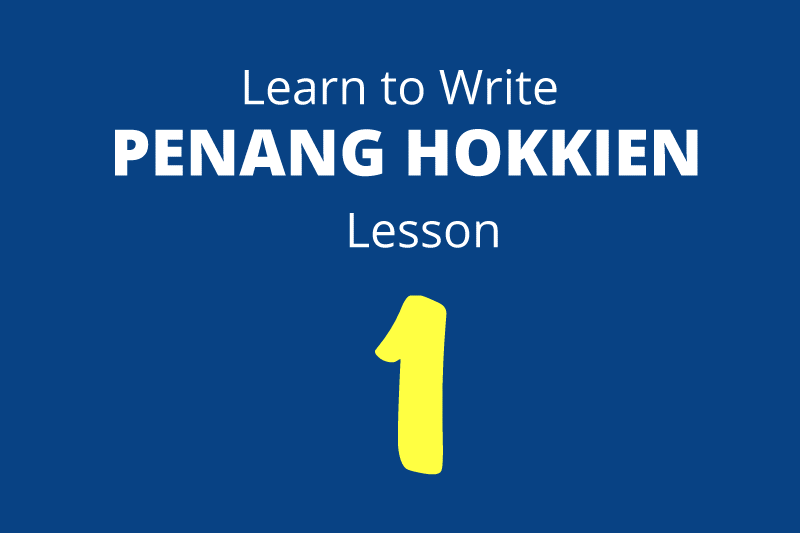
Hello and welcome Everybody!
This month (Feb 2015), there's no posts of questions related to words in Penang Hokkien. Instead we shall spend to learn to write Penang Hokkien using Taiji Romanisation. All the lessons are numbered, so if you miss any, just scroll for them, or look for them in the pinned post. I hope you will enjoy the lessons and gain from them!
The writing system I developed for Penang Hokkien is Taiji Romanisation. It is a homegrown writing system and the only system used and promoted on this Facebook Group. For the benefit of members who are new to the system, this month we shall get to know it bit by bit, understand the common words in writing, so that by and by, you will not only be able to read sentences written in Taiji Romanisation, but could also write your own sentences.
What's the purpose of having a unique writing system for Penang Hokkien? A writing system facilitates the communication in the language. However, it is like a Facebook account. If only one person has a Facebook account, then it's useless. But if everybody owns an account, then we can all communicate with one another using Facebook. When there's a system in place, we can write in the language. We have the means to develop our local literature. We can write stories, compose songs, screenplays, poems, etc. But it starts with a writing system.
To create Taiji Romanisation, I looked at the various writing systems that were created for Hokkien. I looked at how the early missionaries developed their romanised form. By the first half of the 20th century, the form that the missionaries developed, has become the standard for writing Hokkien. As long as there isn't a homegrown system in place, the system used by the missionaries is the one that many learned. I looked at the development of romanised systems in Taiwan. Although many systems were created, eventually the one called Taiwan Romanization System, or Tâi-lô, became the one adopted by the government there. Although it was not spelled out clearly to me why the Taiwanese government chose Tâi-lô over the earlier system developed by the missionaries, when I compare these two systems, I find Tâi-lô to be easier to write. So perhaps that's why it was adopted. However, the use of Tâi-lô is more towards representing the sounds rather than for writing, and the Taiwanese who learn to write Hokkien usually use Chinese characters. This is fine for them, as they are uniformly familiar with Chinese characters.
The situation in Penang is different from that in Taiwan. Over here, it's a plural society. Some of us go to Chinese schools, some to English schools and some to Malay or Tamil schools. As a result, not all of us are uniformly familiar with Chinese characters. Therefore, I decided that a romanized system is the way to go for Penang Hokkien. But right from the out set, I have observed issues with the existing romanised systems, both the one developed by the missionaries as well as the Tâi-lô system. The main obstacle for me is that they use diacritic marks which are difficult to reproduce on standard keyboards. The missionary system in particular is extremely difficult to reproduce, as it includes unique characters. I realise their system was created during an age when people mostly hand-write their communication. Nowadays, we use keyboards and smartphones. The existence of unique characters will hamper the development of Penang Hokkien and keep only a small percentage of the Penang Hokkien-speaking population literate in the language.
As a result, I decided that Penang Hokkien needs its own writing system. After creating the system, I further discover other weaknesses of the "existing" systems which do not take into account my need as a native speaker of Penang Hokkien. For that reason, I decided not to promote any other romanized system for writing Penang Hokkien. They are simply not compatible to my needs. I will however continue to compile Chinese characters, to help speakers of Penang Hokkien become familiar with the characters used for writing Hokkien, and to show that often a different Chinese character is used in Hokkien from Mandarin.
A writing system is more than simply transcribing sounds in one language and spelling them out. Every words should be impregnated with a specific meaning. In English, the words "cut" and "cart" may sound almost the same, but by simply looking at the word, we already know what the meaning should be. People who consider that too difficult to learn should take a look at English or Mandarin, where you also need to learn the meaning of each word.
Should you learn to write Penang Hokkien? That's not something I can answer for anybody. We have to decide whether we want to be literate in a writing system. To me, it is entirely worth the effort, because it unlocks the Penang Hokkien culture.
Taiji Romanisation is created to be intuitive to Malaysians, those who are familiar with English and Malay spelling, and Mandarin tones. You will find elements from all three languages in this system. Many of the words in Taiji Romanisation actually look exactly the same as in the Missionary and Tâi-lô systems, so, to some extend, there are similarities.
In the next and subsequent lessons, we will look at every aspect of the writing system. As long as you follow the lessons and learn from them, you should be on your way towards writing Penang Hokkien in this new writing system.
Main Page | Next Lesson
Language Learning Tools
Use the following language learning tools to learn Penang Hokkien!Learn Penang Hokkien with uTalk
This app opens the door to over 150 languages.Return to Penang Hokkien Resources

Copyright © 2003-2025 Timothy Tye. All Rights Reserved.

 Go Back
Go Back
